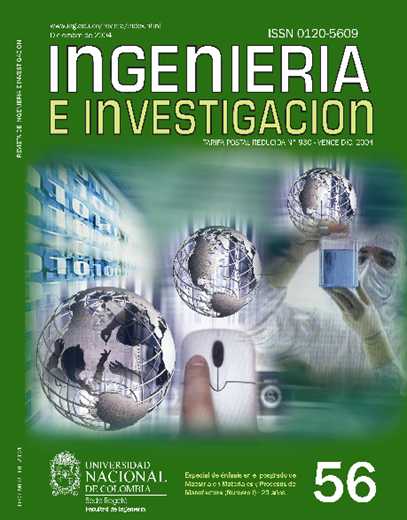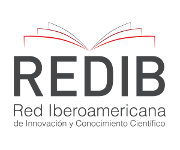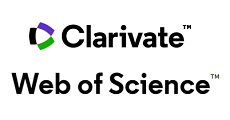Applying axiomatic design methodology in developing modified liberation products
Aplicación de la metodología de diseño axiomático en el desarrollo de productos de liberación modificada
DOI:
https://doi.org/10.15446/ing.investig.v24n3.14609Keywords:
design, functional requirement, design parameter, process variable, axiom (en)diseño, requerimientos funcionales, parámetros de diseño, variables de proceso, axiomas (es)
Downloads
Some conceptual elements regarding the axiomatic design method were applied to a specific case-study regarding developing modified liberation compressed product (CLM-UN), for use in the agricultural sector as pH regulating agent in soil. The study was orientated towards defining functional requirements, design parameters and process variables for manufacturing the product. Independence and information were evaluated, supporting axiomatic design as an alternative for integral product and process design (as a rational and systemic exercise), facilitating producing products having the quality which future users expect from them.
En esta investigación fueron desarrollados algunos elementos conceptuales de la metodología de diseño axiomático para un caso específico de estudio, como es el desarrollo de un comprimido de liberación modificada (CLM-UN), para uso en el sector agrícola como agente regulador de pH en suelo. El estudio se orientó hacia la definición de requerimientos funcionales, parámetros de diseño y variables de proceso, para la manufactura del comprimido. Como resultados se presenta la evaluación de los axiomas de independencia e información. Se encontró que la aplicación de la metodología de diseño axiomático constituye una alternativa para enfrentar la actividad de diseño integral de producto y proceso, como un ejercicio racional y sistémico, que facilita la generación de productos con los atributos de calidad que espera el futuro usuario de éstos.
References
Suh, N., The Principles of Design, Editorial Oxford University Press, New York, 1990.
Suh, N., Axiomatic Design. Advances and Applications, Editorial Oxford University Press, New York, 2001.
Li, H. and S. Azarm., “Product Design Selection Under Uncertainty and with Competitive Advantage”, Journal of Mechanical Design., 122, Dec, 411, 2000. DOI: https://doi.org/10.1115/1.1311788
Du, X. and W. Chen., “Towards a Better Understanding of Modeling Feasibility Robustness in Engineering Design”, Journal of Mechanical Design, December, Vol. 122, pp. 385-393, 2000. DOI: https://doi.org/10.1115/1.1290247
Lin, F, W. Sun and Y. Yan., “Axiomatic Design theory based design rules for mechatronics products”. 5th International Conference on Manufacturing Technology. 2001.
Capetti, N., Axiomatic evaluation of a support plate fuzzy design for electrical accumulator in a motor vehicle, Associazione Nazionale Disegno di Macchine- DIEM, International Conference. Riminiti Italy, September. 2001.
Gawlik, T., A Methodology for facilitating axiomatic design using network partitioning. Degree PHD. University of Central Florida, Dissertation Abstracts, 1996
Stanec, V., An axiomatic based methodology for determining design producibility (product development), Degree PHD. University of Alabama, Dissertation Abstracts, 1994.
Zak, G and M. Sela., Layered - manufacturing of fiber reinforced composites, Journal of Manufacturing Science and Engineering., 121, 448, 1999. DOI: https://doi.org/10.1115/1.2832702
Nordlund, M., D. Tate and N.P Suh., “Growth of Axiomatic Design through Industrial Practice”, 3rd CIRP Workshop on Design and Implementation of Intelligent Manufacturing Systems, Tokyo, June. p 7784,1996.
Park, C. and N. Suh., “Filamentary extrusion of microcellular polymers using a rapid decompressive element”, Polymer Engineering and Science, 1, 34,1996. DOI: https://doi.org/10.1002/pen.10382
Gunasekera, J. and A. Ali, “A Three step approach to designing a metal forming process”, JOM, June, pp. (22-25),1995. DOI: https://doi.org/10.1007/BF03221198
Hintersteiner, J.D and A. Nain, Integrating software into systems: an axiomatic design approach, Proceedings of the 3rd International Conference on Engineering Design and Automation, Vancouver, August, pp. 1-7, 1999.
Yien, T., Manufacturing system design methodology (CIMOSA), axiomatic design, object oriented modelling, Degree PHD. Hong Kong University of Science and Technology. Dissertation Abstracts, 1999.
Hintersteiner, J. and D. Tate., Command and control in axiomatic design theory: its role and placement in the system architecture., Proceedings of the 2nd International Conference on Engineering Design and Automation, Maui, HI. August, pp. 1-5, 1998.
Cochran, D., The design and control of manufacturing systems (axiomatic design, pull system), Degree PHD, Auburn University, Dissertation Abstracts, 1995.
Favela, J., Organizational memory management tor large - scale systems development, Degree PHD, Massachusetts Institute of Technology, Dissertation Abstracts, 1994,
Agouridas, V., J. Baxter, A. McKay and A. Pennington, “On defining product requirements: A case study in the UK health care sector”. ASME 2001, Design Engineering Technical conference and Computers and Information in Engineering conference, Pittsburgh, PA, September, 2001. DOI: https://doi.org/10.1115/DETC2001/DTM-21692
Suh, N., “Designing in of Quality Through Axiomatic Design”, IEEE Transactions on Reliability, 44, 256, 1995. DOI: https://doi.org/10.1109/24.387380
Erazo, F., “Superabsorbent hydrogels and their benefits in forestry applications”, Paper presented at the Intermountain Forest Nursery Association, August Oklahoma City, 1987.
ACS Symposium Series, Superabsorbent Polymers, Science and Technology, Editor Fredric L. Buchholz, Nicholas A. Peppas, American Chemical Society, Washington D.C. Cap. I (2-24), Cap. II (25-36), Cap. III (40-48), Cap. IV (50-62), Cap. VIII (99-111), 1994.
De Liñan y Vicente, C., Farmacología vegetal, Ediciones Agrotécnicas S.L, Madrid, 1997.
Pilatti, R. y M. Buyatti., El agua de riego bicarbonatada y su efecto sobre el cultivo de pimiento, Revista FAVE., I, 28, 1997. DOI: https://doi.org/10.14409/fave.v11i1/2.3047
Kaye-Shoemake, J.L and W.E. Watwood., “Polyacrylamide as a substrate microbial amidase”, Soil Bio and Biochem, 30, 1647, 1998a. DOI: https://doi.org/10.1016/S0038-0717(97)00251-4
Kaye-Shoemake, J.L and W.E. Watwood., “Polyacrylamide as an organic source for soil microorganisms with potential impact on inorganic soil nitrogen in agricultural soil”, Soil Bio and Biochem, 30, 1045, 1998b. DOI: https://doi.org/10.1016/S0038-0717(97)00250-2
Martinez, C.E., A.W. Kleinschmidt and M.A. Tabatabai., “Sulfate adsorption by variable charge soils: Effect of low molecular weights organic acids”, Biology and Fertility of Soils., 26, 157, 1998. DOI: https://doi.org/10.1007/s003740050361
Amado, L.G. y J.C. Orozco, Síntesis de un hidrogel a partir de acrilamida y ácido acrílico por copolimerización inversa para la liberación controlada de un fertilizante tesis de grado, carrera de ingeniería química, Universidad Nacional de Colombia, Bogotá, 2002.
Rudzinski W., T. Chipuk., A. Dave., S. Kumbar and T. Aminabhavi, “pH- Sensitive Acrylic-Based Copolymeric Hydrogels for the Controlled Release of a Pesticide and a Micronutrient”, Journal of Applied Polymer Science., 87, 394, 2003. DOI: https://doi.org/10.1002/app.11382
Aulton, M, Pharmaceutics The Science of Dosage Form Design, 2nd Edition, M.E. Aulton, Leicester U.K, 2002.
Florence, A.T and D. Attwood., Physicochemical Principles of Pharmacy. 3rd edition, Creative Print & Design, Great Britain, pp. 308-370, 1998. DOI: https://doi.org/10.1007/978-1-349-14416-7_9
How to Cite
APA
ACM
ACS
ABNT
Chicago
Harvard
IEEE
MLA
Turabian
Vancouver
Download Citation
License
Copyright (c) 2004 Bibiana Margarita Vallejo Díaz, Carlos Julio Cortés Rodríguez, Armando Espinosa, Helber J. Barbosa B.

This work is licensed under a Creative Commons Attribution 4.0 International License.
The authors or holders of the copyright for each article hereby confer exclusive, limited and free authorization on the Universidad Nacional de Colombia's journal Ingeniería e Investigación concerning the aforementioned article which, once it has been evaluated and approved, will be submitted for publication, in line with the following items:
1. The version which has been corrected according to the evaluators' suggestions will be remitted and it will be made clear whether the aforementioned article is an unedited document regarding which the rights to be authorized are held and total responsibility will be assumed by the authors for the content of the work being submitted to Ingeniería e Investigación, the Universidad Nacional de Colombia and third-parties;
2. The authorization conferred on the journal will come into force from the date on which it is included in the respective volume and issue of Ingeniería e Investigación in the Open Journal Systems and on the journal's main page (https://revistas.unal.edu.co/index.php/ingeinv), as well as in different databases and indices in which the publication is indexed;
3. The authors authorize the Universidad Nacional de Colombia's journal Ingeniería e Investigación to publish the document in whatever required format (printed, digital, electronic or whatsoever known or yet to be discovered form) and authorize Ingeniería e Investigación to include the work in any indices and/or search engines deemed necessary for promoting its diffusion;
4. The authors accept that such authorization is given free of charge and they, therefore, waive any right to receive remuneration from the publication, distribution, public communication and any use whatsoever referred to in the terms of this authorization.



























